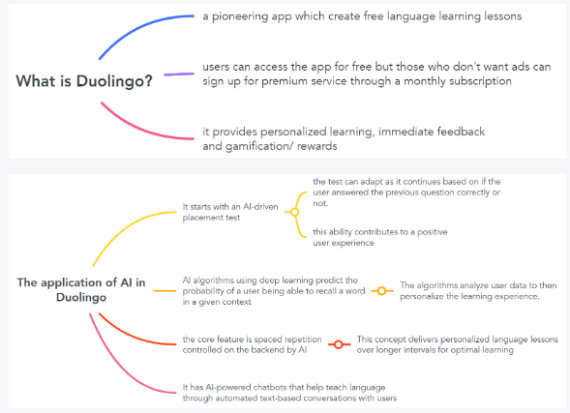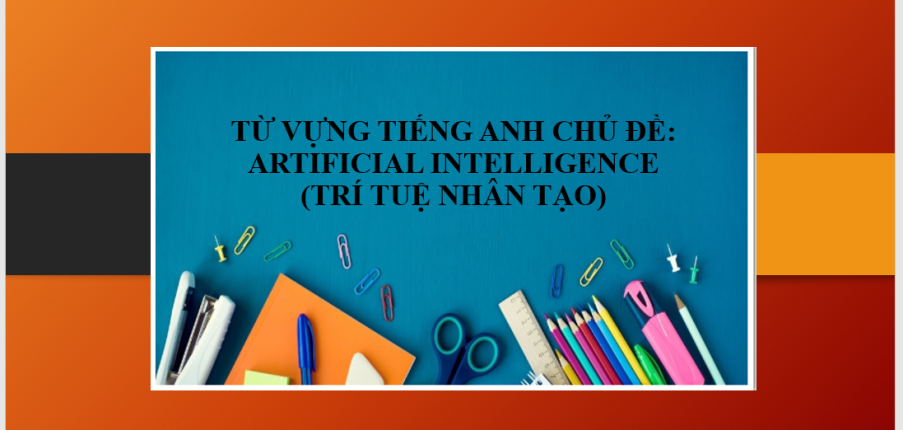Từ vựng tiếng Anh chủ đề: Artificial Intelligence (Trí tuệ nhân tạo) | Ứng dụng vào IELTS Speaking - Bài tập vận dụng
Học từ vựng qua bài đọc chủ đề Artificial Intelligence
Artificial Intelligence (trí tuệ nhân tạo) là một trong những chủ đề quen thuộc trong IELTS. Thời gian gần đây, các chủ đề về Speaking về Robot, Machine, ….
Trích đoạn 1:
Machine learning works by training the machine on vast quantities of data – pictures for image-recognition systems, or terabytes of prose taken from the internet for bots that generate semi-plausible essays, such as GPT2. But datasets are not simply neutral repositories of information; they often encode human biases in unforeseen ways. Recently, Facebook’s news feed algorithm asked users who saw a news video featuring black men if they wanted to “keep seeing videos about primates”. So-called “AI” is already being used in several US states to predict whether candidates for parole will reoffend, with critics claiming that the data the algorithms are trained on reflects historical bias in policing.
(Dịch: Phương thức hoạt động của máy học là qua việc đào tạo máy về lượng dữ liệu hình ảnh khổng lồ để phát triển hệ thống nhận dạng hình ảnh hoặc sử dụng các terabyte lấy từ internet cho các bot tạo ra các mô hình ngôn ngữ, chẳng hạn như GPT2. Nhưng bộ dữ liệu không chỉ đơn giản là kho lưu trữ thông tin trung lập; chúng thường mã hóa những thành kiến của con người theo những cách không lường trước được. Gần đây, thuật toán cho bảng tin của Facebook đã đề xuất video tin tức về người da màu khi người dùng muốn “tiếp tục xem video về động vật linh trưởng”. Cái gọi là “trí tuệ nhân tạo” đang được sử dụng ở một số bang của Hoa Kỳ để dự đoán liệu các ứng cử viên được ân xá có tái phạm hay không, đã bị các nhà phê bình cho rằng chúng phản ánh sự thiên vị trong việc lập chính sách.)
Từ vựng:
1/ Machine learning /məˈʃiːn/ /ˈlɜːnɪŋ/: máy học.
Đây là một nhánh trong trí tuệ nhân tạo và khoa học máy tính. Lĩnh vực này tập trung vào việc sử dụng dữ liệu và thuật toán để bắt chước cách con người tiếp thu thông tin, từ đó tăng tính chính xác trong các phép tính hoặc đưa ra quyết định mà không cần lập trình sẵn.
Eg: Machine learning is a vital component in the field of data science.
(Máy học là thành tố quan trọng trong lĩnh vực khoa học dữ liệu)
2/ Image-recognition system /ˈɪmɪdʒ - ˌrekəɡˈnɪʃn/ /ˈsɪstəm/: Hệ thống nhận diện hình ảnh.
“Image-recognition” là một thuật ngữ để chỉ khả năng nhận diện đồ vật, con người, vị trí dựa vào các hình ảnh chụp được. Máy tính sẽ kết hợp với camera và trí tuệ nhân tạo để chứng thực được nhận diện hình ảnh. Xét về góc độ ngôn ngữ, “image-recognition” là một tính từ ghép. Với cách ghép từ như này, người học có thể suy luận được những cụm từ có kết cấu tương tự như “voice-recognition” là nhận diện giọng nói, “sound-recognition” là nhận diện âm thanh, “face-recognition” là nhận diện gương mặt.
Eg: Today, Google translation can scan images and use the image-recognition function to translate languages for users.
(Hiện này, Google dịch có thể quét hình ảnh và sử dụng chức năng nhận diện hình ảnh để dịch các ngôn ngữ cho người dùng.)
3/ Encode /ɪnˈkəʊd/: mã hóa
Xét về góc độ thuật ngữ trong lĩnh vực máy tính - cộng nghệ, động từ “encode” có nghĩa là “thay đổi thông tin theo dạng thức mà có thể được hiểu bởi ngôn ngữ máy tính”. Trong tiếng Anh, “decode” và “encode” là hai từ có nghĩa khác nhau. Nếu như “encode” mang nghĩa mã hóa (thay đổi những ký tự, chữ cái thông thường thành biểu tượng… để máy tính hiểu hoặc gửi thông điệp ngầm) thì “decode” có nghĩa là giải mã (chuyển đổi những chữ cái đặc biệt sang ngôn ngữ thông thường để hiểu nội dung).
Eg: This new type of scanner can encode characters on a page and store them electrically.
(Loại máy quét mới có thể mã hóa các ký tự trên một trang giấy và lưu trữ chúng một cách điện tử.)
4/ Algorithm /ˈælɡərɪðəm/: thuật toán
Trong khoa học máy tính, thuật toán là một tập hợp các hướng dẫn, các bước được xác định rõ ràng có thể thực hiện bởi máy tính để giải quyết một vấn đề nào đó. Hiện nay, bất kỳ một mạng xã hội nào đều được lập trình với những thuật toán để làm xuất hiện các quảng cáo hoặc các bài viết liên quan đến sản phẩm/ dịch vụ một cách tự động dựa vào thông tin được tìm kiếm gần nhất bởi người dùng.
Eg: If you look for a hotel in Danang on Google, your newsfeed will automatically show online advertisements of booking services at the destination based on Facebook’s algorithm.
(Nếu bạn tìm kiếm một khách sạn ở Đà Nẵng trên Google, newsfeed của bạn sẽ tự động hiện những quảng cáo về dịch vụ đặt phòng tại điểm đến đó dựa theo thuật toán của Facebook.)
Trích đoạn 2
Computerised systems (as in aircraft autopilots) can be a boon to humans, so the flaws of existing “AI” aren’t in themselves arguments against the principle of designing intelligent systems to help us in fields such as medical diagnosis. The more challenging sociological problem is that adoption of algorithm-driven judgments is a tempting means of passing the buck, so that no blame attaches to the humans in charge – be they judges, doctors or tech entrepreneurs. Will robots take all the jobs? That very framing passes the buck because the real question is whether managers will fire all the humans.
(Dịch: Các hệ thống máy tính hóa (như trong hệ thống lái tự động của máy bay) có thể mang lại lợi ích cho con người, do đó, việc “AI” vẫn còn một số sai sót ở hiện tại không phải là lý lẽ để chống lại việc thiết kế các hệ thống thông minh để giúp con người trong các lĩnh vực như chẩn đoán y tế. Vấn đề xã hội học thách thức hơn là việc áp dụng các phán đoán dựa trên thuật toán có thể dẫn đến việc đổ lỗi vào máy, từ đó con người sẽ không cần chịu trách nhiệm - dù họ là thẩm phán, bác sĩ hay doanh nhân công nghệ. Liệu robot sẽ đảm nhận tất cả các công việc? Câu hỏi này mang tính đổ lỗi bởi vì câu hỏi thực sự phụ thuộc vào việc các nhà quản lý có sa thải tất cả con người hay không.)
Từ vựng
5/ Computerised system /kəmˈpjuːtəraɪzd/ /ˈsɪstəm/: hệ thống vi tính hóa
Hệ thống vi tính hóa có nghĩa là các chương trình, vận hành của một bộ máy sẽ được thực hiện tự động bởi máy tính, không cần có sự can thiệp của con người. Khi máy tính được lập trình để vận hành tự động, chắc hẳn sẽ có những sai sót do khuyết thiếu câu lệnh nào đó. Chính vì vậy, sẽ cần có “computerised system validation” - quá trình kiểm tra/ đánh giá những chương trình đã được tạo lập để đảm bảo hệ thống vi tính hóa vẫn chạy theo đúng những gì được lập trình.
Eg: Aircraft autopilot is a typical example of computerised system, which proves that computers can repeat tasks perfectly without human intervention.
(Máy bay lái tự động là ví dụ điển hình của hệ thống vi tính hóa, cái chứng minh rằng máy tính có thể lặp lại các nhiệm vụ hoàn hảo mà không cần sự can thiệp của con người.)
6/ Algorithm-driven judgment /ˈælɡərɪðəm - ˈdrɪvn/ /ˈdʒʌdʒmənt/: đánh giá dựa trên thuật toán
Cụm từ này cũng có thể được hiểu như “Data - predictive modelling” - phương pháp sử dụng số liệu và thuật toán để dự đoán kết quả.
Eg: Nowadays, people prefer algorithm-driven to human judgment because of its rapidness and accuracy.
(Ngày nay, con người thích đánh giá dựa trên thuật toán vì tính nhanh và chính xác.)
Ứng dụng trong kỹ năng Speaking chủ đề Artificial Intelligence
Đề bài
Describe a product or application which is based on artificial intelligence
You should say:
- What it is
- What it is used for
- How it is used
And explain what you think of it
Dàn bài

Bài mẫu
AI is a buzzword in this day and age. When it comes to an app related to AI, the one popping up in my mind is Duolingo, which is a language learning app on my mobile phone.
Basically, it is developed to run smoothly on both smartphones and websites. It can be compatible with Android and IOS operating systems. Thanks to the amazing AI application, Duonlingo has become a household name for those who want to self-study foreign languages.
The app not only helps people learn English but also many other foreign languages such as French, Spanish, German, Japanese … Users can access for free and if ones do not want to see advertisements, the monthly subscription is a suitable choice.
After you download and sign up for an account, you choose a foreign language that you’d love to study and have to do an AI-driven placement test which is automatically adapted based on the number of correct answers. Then the test will provide Duolingo a good sense of what your level is and where you should begin. Moreover, the app takes advantage of voice-recognition technology to record and assess users’ pronunciation and speaking skills. Users can visit the app at any time, if the intervals between each lesson are long, Duolingo will send you a notification via your email and phone to remind you of your learning journey. That’s interesting!
To me, Duolingo is an impressive tool to improve learning productivity and efficiency. The app provides a personalized learning experience, immediate feedback, and point-based rewards to motivate learners. The algorithm is designed to predict the possibility of learners being able to remember and pronounce a word. Duolingo has helped me a lot when I am trying to learn French from scratch. It has a massive number of lessons so that I can practice listening, reading and grammar. The most useful feature is that the app records how many streaks you have made and saves how many points you have earned after each topic. I think Duolingo is a must app for learners to master all foreign languages.
Từ vựng
1/ buzzword /ˈbʌzwɜːd/: từ được sử dụng rộng rãi
2/ compatible /kəmˈpætəbl/: tương thích
3/ operating system /ˈɒpəreɪtɪŋ sɪstəm/: hệ điều hành
4/ AI-driven placement test /ˌeɪ ˈaɪ - drɪvn ˈpleɪsmənt test/: bài kiểm tra đầu vào dựa trên trí tuệ nhân tạo
5/ voice-recognition technology /vɔɪs - rekəɡˈnɪʃn tekˈnɒlədʒi/: công nghệ nhận diện giọng nói
6/ personalized learning experience /ˈpɜːsənəlaɪzd lɜːnɪŋ ɪkˈspɪəriəns/: trải nghiệm học được cá nhân hóa
Bài tập ứng dụng
Bài tập 1: Fill in the blanks with the correct words

1/ HTML is the programming language used to ______ documents to that they can be displayed on any computer which has access the Web.
2/ Music apps use ________ to predict the probability that fans of one particular band will like another
3/ This paper designs an _________ based on BP neural network and multi -sensor data fusion.
4/ _______ is the study of computer algorithms that can improve automatically through experience and by the use of data.
5/ Aircraft autopilots usually need _______ to assess whether they are as safe, secure and reliable as paper records
Đáp án:
1. encode
2. algorithms
3. image-recognition system
4. Machine learning
5. computerised system validation
Bài tập 2: Choose the correct answer to complete the sentences.
1/ An _______ is a type of artificial intelligence that can simulate human conversation.
a) algorithm
b) chatbot
c) hardware
2/ _______ learning involves machines improving from past data and experiences without being explicitly programmed.
a) Supervised
b) Reinforcement
c) Machine
3/ _______ is a branch of AI that deals with the creation of robots.
a) Robotics
b) Data mining
c) Natural language processing
4/ _______ networks are a type of machine learning model inspired by the human brain.
a) Artificial
b) Neural
c) Decision
5/ _______ is used to describe the ability of machines to understand and interpret human language.
a) NLP
b) CV
c) RPA
Đáp án:
1. b) chatbot
2. c) Machine
3. a) Robotics
4. b) Neural
5. a) NLP
Bài tập 3: Determine if the following statements are true or false.
1/ Artificial intelligence can only perform tasks that humans can do.
2/ Machine learning algorithms require large amounts of data to be effective.
3/ AI can be used in healthcare to predict patient outcomes.
4/ Neural networks are not related to human brain function.
5/ Chatbots can only be used for customer service.
Đáp án:
1. False
2. True
3. True
4. False
5. False
Bài tập 4: Match the AI terminology with its correct definition.
1/ Algorithm
2/ Big Data
3/ Deep Learning
4/ Supervised Learning
5/ Autonomous Vehicle
a) A set of rules or steps used to solve a problem.
b) A system that learns from labeled data.
c) A type of machine learning using neural networks with many layers.
d) Large volumes of data that can be analyzed for insights.
e) A vehicle capable of sensing its environment and operating without human intervention.
Đáp án:
1. a) A set of rules or steps used to solve a problem.
2. d) Large volumes of data that can be analyzed for insights.
3. c) A type of machine learning using neural networks with many layers.
4. b) A system that learns from labeled data.
5. e) A vehicle capable of sensing its environment and operating without human intervention.
Bài tập 5: Fill in the blanks with the correct terms related to AI.
1/ _______ vision enables machines to interpret and make decisions based on visual data.
2/ _______ is a subfield of AI focused on enabling machines to learn from data.
3/ In _______ learning, models are trained using labeled data.
4/ _______ analysis is used to discover patterns in large datasets.
5/ _______ reasoning is a process in AI that mimics human problem-solving.
Đáp án:
1. Computer
2. Machine learning
3. supervised
4. Data
5. Logical
Bài tập 6: Form the correct word related to AI from the given root.
1/ Automate - The company is investing in _______ solutions.
2/ Predict - The AI system can make accurate _______.
3/ Recognize - Facial _______ technology is improving rapidly.
4/ Interpret - Natural language _______ is a key challenge in AI.
5/ Train - Machine learning requires substantial data for _______.
Đáp án:
1. automation
2. predictions
3. recognition
4. interpretation
5. training
Bài tập 7: Match each AI term with its synonym.
1/ Algorithm
2/ Neural Network
3/ Data Mining
4/ Machine Learning
5/ Artificial Intelligence
a) Data extraction
b) Model
c) Procedure
d) AI
e) Deep learning
Đáp án:
1. c) Procedure
2. e) Deep learning
3. a) Data extraction
4. b) Model
5. d) AI
Bài tập 8: Identify the antonym for each AI term.
1/ Supervised Learning
2/ Artificial
3/ Structured Data
4/ Autonomous
5/ Centralized System
Đáp án:
1. Unsupervised Learning
2. Natural
3. Unstructured Data
4. Manual
5. Distributed System
Bài tập 9: Complete the sentences with the correct AI terminology.
1/ _______ systems can perform tasks that typically require human intelligence.
2/ _______ uses algorithms to discover patterns in large datasets.
3/ A _______ network is a machine learning model inspired by the human brain.
4/ _______ is the process of converting spoken language into text.
5/ _______ learning uses reinforcement to improve decision-making.
Đáp án:
1. Artificial Intelligence
2. Data mining
3. neural
4. Speech recognition
5. Reinforcement
Bài tập 10: Provide the definition for each AI term.
1/ Artificial Intelligence
2/ Deep Learning
3/ Machine Learning
4/ Natural Language Processing
5/ Robotics
Đáp án:
1. Artificial Intelligence - The simulation of human intelligence processes by machines, especially computer systems.
2. Deep Learning - A subset of machine learning involving neural networks with many layers.
3. Machine Learning - A type of AI that enables computers to learn from and make decisions based on data.
4. Natural Language Processing - A branch of AI focused on the interaction between computers and humans through natural language.
5. Robotics - The branch of technology that deals with the design, construction, operation, and application of robots.
Xem thêm các tài liệu Tiếng Anh hay, chi tiết khác:
TOP Việc làm "HOT" dành cho sinh viên:





